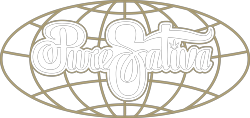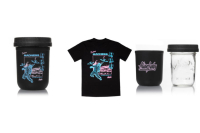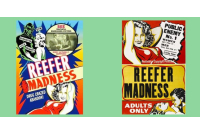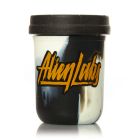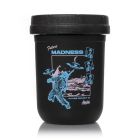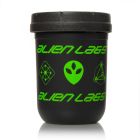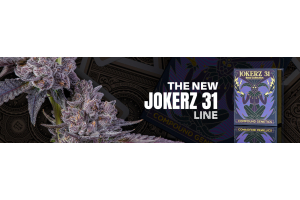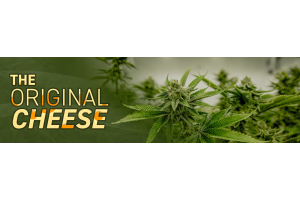Alien Labs, 'Reefer Madness' and Prohibition

Who are Alienlabs?
Alienlabs is an 'out of this world' cannabis company born in Northern California. The Alienlabs' connoisseurs have dynamic energy and an extraordinary passion for the cannabis industry, verified by their elite flowers and extracts. They have expanded into a range of iconic merch showcasing their genius graphics so we can rep their brand worldwide. Alienlabs envision itself as "transmitting from 2069", a company ahead of its time. The generic definition of an 'alien' is an extraterrestrial life from another planet more intelligently advanced than humans. So, Alienlabs imply their creations are the epitome of futuristic and state-of-the-art.
Spotlighting 'Future Madness' merch by Alienlabs
At first glance, the showstopping graphics for the Future Madness T-Shirt by Alien Labs and Future Madness 8oz AlienLabs Mason Stash Jar by RE: STASH is an epic sci-fi image of alien abduction. However, after taking in the artwork, we realise 'Future Madness' alludes to the sheer insanity of the Reefer Madness film and related propaganda posters.
Alien Labs' playfully satirises the Reefer Madness posters by swapping the Devil luring 'innocent' young white men and women with UFOs abducting a human. The image allows us to reflect on an era where many people and communities still have to pay the price. So, let's talk prohibition.
'Reefer Madness' and the history of U.S. Cannabis prohibition
The 'Reefer Madness' was a 1936 propaganda film that emphasised cannabis as a dangerous and demonic drug. Events leading up to the production of 'Reefer Madness' and subsequent proceedings reveal the racially charged motivations surrounding the criminalisation and attitudes toward cannabis, still grossly affecting today's lives.
A rush of Mexican immigrants fled to the U.S. during the political violence of the Mexican Revolution in the early 1900s. They brought the culture of smoking cannabis recreationally with them. As a result, the Spanish spelling of cannabis, known then as 'marihuana' and better recognised as marijuana today, became negatively popularised, referred to as the "marijuana menace". However, the dramatic increase in unemployment due to the Great Depression also increased widespread animosity toward immigrants and ethnic minorities. Consequently, the narrative associating drugs with immigrants and minorities further escalated.
Harry J. Anslinger was a pioneer in cruelly driving racial discrimination by manipulating and feeding white Americans' attitudes toward immigrants and minorities, associating them with the drug. Anslinger was the head of the Federal Bureau of Narcotics, and after prohibition was over in 1933, his objective focus became the criminalisation of cannabis. The release of 'Reefer Madness' supported Anslinger's brainwashing agenda. The film's storyline surrounds innocent high school students who are tempted by and try cannabis. Their consumption of the so-called "demon weed" leads to a sequence of horrifying events, including attempted rape, manslaughter, suicide and intensified hallucinations.
Harry Anslinger blindly developed anti-cannabis propaganda without any scientific backing, portraying it as a getaway and violent drug. He said cannabis immediately causes "insanity, criminality and death." He even went as far as to claim, "You smoke a joint, and you are likely to kill your brother." Anslinger placed stress on the word 'marihuana' to negatively associate the drug with Mexican immigrants. He also freely said that cannabis allowed black people to believe they were equal to white people. Furthermore, he fuelled the view that jazz music is sinful and satanic because it was produced by cannabis consumers, fully knowing that jazz musicians predominately consisted of black artists.
His anti-cannabis campaigns included false stories and accusations that black men were dangerous and lured young, innocent white women to become sex-crazed and addicted to the drug. His warped crusade was said with conviction bought by the American people and broadly publicised by the media, playing into his nasty plot. Although Harry Anslinger's campaign was factless and driven by his racist ideologies, he succeeded as head of the Bureau of Narcotics for 30 years.
Prompted by Anslinger's nationwide indoctrination, Congress passed the Marihuana Tax Act of 1937, allowing only those who paid a hefty tax for industrial and medical cannabis manufacturing to be in possession. Essentially the Act regulated and prevented recreational consumption. Those who ignored the Act were fined $2,000 and/ or imprisonment for up to five years. The Act further enabled racial prejudice, where due to drug laws, black people were three times more likely to be arrested than their white counterparts. Mexicans were almost nine times more likely than white people for the same charge. Laws tightened up further on the possession of cannabis due to the 1951 Boggs Act. The Act concluded that a first offence conviction for possession was a fine of up to $20,000 and a minimum sentence of two to ten years.
However, following these tight laws and regulations, the counterculture of the 60s and 70s was born. Famously recognised as the hippy or flower power era, this mainstream culture became a movement where young white people defied institutional barriers. Through this counterculture, cannabis smoking became widely loved and appreciated by white Americans. During this era, presidents John Kennedy and Lyndon Johnson commissioned reports concluding cannabis consumption did not cause violence and was not a gateway drug. However, this promising and liberal culture was short-lived when President Nixon came into power.
Much like Harry Anslinger, Nixon's hatred toward cannabis was unrelated to scientific evidence. Instead, his bitterness toward the counterculture, which challenged his ideologies and biased views of ethnic minorities, influenced his perception of cannabis. For example, in a 1994 interview, later released in 2016, the counsel and assistant to the President for Domestic Affairs, John Ehrlichman, said that:
"The Nixon campaign in 1968, and the Nixon White House after that, had two enemies: the antiwar left and black people. You understand what I'm saying? We knew we couldn't make it illegal to be either against the war or black, but by getting the public to associate the hippies with marijuana and blacks with heroin, and then criminalising both heavily, we could disrupt those communities. We could arrest their leaders, raid their homes, break up their meetings, and vilify them night after night on the evening news. Did we know we were lying about the drugs? Of course we did."
Following Nixon's dangerously prejudiced and harmful campaign, the Controlled Substance Act was authorised in 1910. Under Nixon, cannabis became a schedule 1 drug alongside heroin, LSD and ecstasy. However, after Nixon's famous announcement of his war on drugs, in 1972, the National Commission on Marihuana and Drug Abuse presented its findings in the report: "Marihuana, A Signal of Misunderstanding". The report found that cannabis did not pose a threat to society. Rather, they discovered that cannabis consumers were "timid, drowsy and passive." Their conclusion suggested that other tolerant methods could discourage the usage of cannabis instead of criminal charges. Even though Nixon commissioned the report himself, he dismissed the research surrounding cannabis and continued his war on drugs. The report did prove successful in altering state governments' decisions, with the first decriminalisation of cannabis in 1973, Oregon. Today, cannabis is legal in 18 states: Colorado, Washington, Alaska, Oregon, Washington, D.C., California, Maine, Massachusetts, Nevada, Michigan, Vermont, Guam, Illinois, Arizona, Montana, New Jersey, New York, Virginia, New Mexico, Connecticut.
President Reagan maintained the same intolerable view as Nixon towards cannabis and black people. He made his stance on cannabis widely known, making continuous sweeping statements such as:
"Marijuana is probably the most dangerous drug in America today."
"I now have absolute proof that smoking even one marijuana cigarette is equal in brain damage to being on Bikini Island during an H-bomb blast."
In 1986 Reagan signed the Anti-Drug Abuse Act. The Act declared mandatory sentences for crimes associated with drugs. For example, there was an increase in federal penalties for selling and possessing cannabis. Black people were and continue to be arrested at dramatically higher rates than white people, ignoring similar consumption. The consequences for black and Mexican people, ethnic minorities, and those integrated into the counterculture were highly harmful. It is vital to know the motivations and history of anti-cannabis propaganda because the effects are still harming families today.
